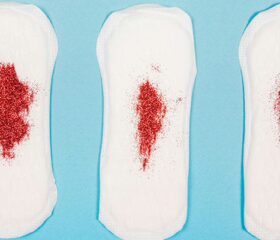Postpartum Cramping: Causes, How Long It Lasts, and How to Get Relief
Although the marathon of pregnancy and childbirth is now behind you, you may still have to deal with uncomfortable postpartum symptoms like cramping.

Postpartum cramps, also known as afterpains, often feel like menstrual cramps, and can range from mild to quite intense. You’ll usually notice them more in the first few days after delivery.
While these can be uncomfortable, postpartum cramping is an entirely normal part of the healing process. These cramps are a sign that your body is working hard to recover and return to its pre-pregnancy state.
Let’s take a look at what causes postpartum cramping, how long it typically lasts, and when it might be a sign of something more serious.
What causes postpartum cramping?
Postpartum cramping is usually the result of your uterus shrinking back to its normal size after you give birth.
During pregnancy, your uterus grows to about the size of a watermelon to accommodate your baby. 1 Once you give birth, your body immediately begins the process of shrinking your uterus back to its original pear-like size, which is known as “involution.”
The contractions that you feel are the necessary muscular work your body needs to shrink your uterus. Moreover, these contractions also compress the blood vessels where your placenta was attached, which can prevent complications like a postpartum hemorrhage.
How breastfeeding affects afterpains
If you’re breastfeeding your baby, you might notice that your cramps are stronger during or immediately after feeding. This is a normal reaction to the release of oxytocin, often known as the “love” hormone. 2
Oxytocin causes contractions during labor, and it also helps your uterus shrink more efficiently.
What else can cause pain or cramping postpartum?
While uterine involution is the most common reason to experience pain or cramping during the postpartum period, this condition can be worsened by:
- Your C-section recovery: If you had a C-section delivery, you’ll still experience afterpains as your uterus contracts. You may also feel additional discomfort in your lower abdomen or on your C-section scar as a result of the surgery.
- Constipation: It’s normal for your digestive system to be a little sluggish after giving birth, and you may have to contend with postpartum constipation. Certain pain medications or a lack of activity during your recovery can also cause constipation, bloating, and a general feeling of pressure. 3
- Endometritis: This infection of the uterine lining is very common after giving birth. If your cramps are caused by endometritis, you may find they get worse over time, and you may also experience symptoms like a fever, foul-smelling vaginal discharge, and pelvic pain. 4
- Urinary tract infections (UTIs): An infection anywhere in your urinary system can cause pelvic pain and cramping. You’ll know a UTI is to blame if you also have symptoms like a burning sensation when peeing, feeling a frequent or urgent need to pee, and cloudy or bloody urine.
Note that if your cramps are caused by endometritis or a UTI, you’ll need to speak with your doctor to get antibiotics.
How long do postpartum cramps last?
Breathe a sigh of relief; most women find that their afterpains start to ease up or even disappear 2–3 days after giving birth. 5
However, it will take about 6 weeks for your uterus to return to its pre-pregnancy size and weight, so you may still have to contend with some cramping for several weeks. 6 7
Moreover, cramping caused by constipation or an infection won’t resolve on its own and will last until you get treatment.
Your postpartum cramps may be stronger if this wasn’t your first pregnancy
If you aren’t a first-time mom, you’re more likely to experience afterpains. This is due in part to your nerves being sensitized from your first pregnancy. If you had this unpleasant symptom after your first baby, you may also find that it’s stronger or more noticeable when you give birth to your second or third kid. 7
How to find relief from postpartum cramps
Although cramping is a normal (and even necessary) part of your postpartum recovery, you don’t have to suffer through it unaided.
There are a few simple home remedies you can use to get relief from postpartum cramps so you can focus on your recovery and caring for and bonding with your baby.
You can try:
- Using a heating pad: A little warmth can work wonders. Use a heating pad on a low setting or a hot water bottle wrapped in a towel to get relief from your cramps. You could also take a warm shower to relax your muscles.
- Gentle movement: Though it might be the last thing you feel like doing, going for a short, gentle walk may ease your cramping. As a bonus, it’s also one of the best ways to get your digestive system moving and relieve constipation.
- Keeping your bladder empty: A full bladder can stop your uterus from contracting properly, which may only make your cramps worse. Try to urinate frequently, even if you don’t feel a strong urge.
- Using relaxation techniques: When your cramps strike, try to take deep breaths, similar to those you may have used during labor.
- Changing your position: Sometimes, simply lying face down with a pillow placed under your lower belly can ease your pain. You could also ask your partner, a friend, or a family member to give you a gentle abdominal massage.
- Using a belly band: You may find that the gentle compression and support of a belly band or abdominal wrap makes your cramping less intense.
- Drinking something warm: A warm cup of tea or another kind of hot drink can soothe your entire body, including your contracting muscles.
If you think constipation is the culprit behind your cramps, make sure you also stay hydrated and fill your postpartum diet with high-fiber foods like fruits, vegetables, and whole grains. If you need more help, ask your doctor about an over-the-counter stool softener that’s safe to use while breastfeeding.
Can you take over-the-counter medications for postpartum cramping?
If your pain is unbearable or doesn’t ease up with the home remedies outlined above, you could look into over-the-counter pain relievers like ibuprofen to ease your cramps.
However, you should always consult with your doctor before starting any new medications (including over-the-counter ones), especially if you’re breastfeeding, as you could unintentionally pass certain drugs to your baby via your breast milk.
When to call your doctor about postpartum cramping
Most of the time, postpartum cramping is just a necessary, albeit irritating, part of your recovery. That said, severe pain or cramping that’s accompanied by other, more worrying symptoms could also be a sign of something more serious.
Get in touch with your doctor if your pain gets worse over time or you experience:
- Symptoms of an infection: A fever of over 100.4°F (38°C), foul-smelling vaginal discharge, or redness, warmth, or swelling around your C-section scar are all telltale signs of an infection.
- UTI symptoms: As mentioned, a burning pain when you pee, pelvic pain, or needing to pee more frequently are classic UTI symptoms.
- Heavy bleeding: While postpartum bleeding (lochia) is normal, it shouldn’t be excessive. Speak to your doctor immediately if you soak through more than one pad an hour or are passing very large blood clots.
- Severe swelling: Postpartum swelling is quite common and usually nothing too serious. However, severe swelling in your face, hands, feet, or limbs could be a sign of postpartum preeclampsia, a dangerous form of high blood pressure. 8
The American College of Obstetricians and Gynecologists (ACOG) recommends that you go in for a check-up with your doctor in the first 3 weeks of giving birth, and again 12 weeks after delivery. 9
However, don’t hesitate to get in touch with your doctor sooner if you experience any of these more troubling symptoms.
Final thoughts
Unfortunately, pain and cramps are often a normal part of your postpartum recovery. Take heart in knowing that postpartum cramping is usually a sign that your body is recovering just as it needs to. Think of it as a temporary hiccup as you get back to your normal self.
In the meantime, keep an eye on your symptoms, try out simple home remedies to find relief, and let your doctor know if your pain gets worse or you have other concerns.
Article Sources
- American Pregnancy Association. "Normal Uterus Size During Pregnancy" Retrieved October 21, 2025.
- Mayo Clinic. "Labor and delivery, postpartum care" Retrieved October 21, 2025.
- Cleveland Clinic. "What To Know About Pooping After Giving Birth" Retrieved October 21, 2025.
- Cleveland Clinic. "Endometritis" Retrieved October 21, 2025.
- Tommy’s. "Your body after the birth (the first 6 weeks)" Retrieved October 21, 2025.
- Mass General Brigham. "Postpartum Pain Management" Retrieved October 21, 2025.
- American College of Obstetricians & Gynecologists. "Postpartum Pain Management" Retrieved October 21, 2025.
- Cleveland Clinic. "Postpartum Preeclampsia" Retrieved October 21, 2025.
- American College of Obstetricians & Gynecologists. "Optimizing Postpartum Care" Retrieved October 21, 2025.







